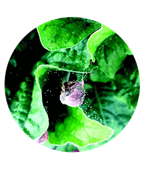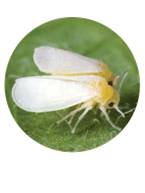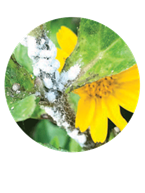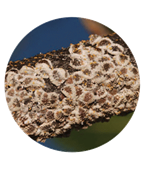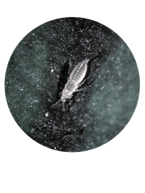Aphids
Aphids are among the most common insect pests on plants. Many species of aphids feed on ornamental nursery and greenhouse crops.
The Problem
Aphids are among the most common insect pests on plants. Many species of aphids feed on ornamental nursery and greenhouse crops. Primary aphid pests of ornamental plants include the green peach and melon aphids. Aphids have tremendous reproductive potential and in large numbers can cause significant damage and reduce plant quality. Certain species feed on foliage, others on petioles and branches, some on flowers or fruit and some aphids feed on roots. In addition to direct damage, aphids are capable of transmitting plant viruses making aphid management critical in commercial production settings.
What To Look For
Aphids are typically found clustering on succulent young shoots and leaves, although some species occur on flowers, branches and/or roots. Most adult aphids are about an eighth of an inch long, pear-shaped and can vary widely in color from green to yellow, pink or black. They are soft-bodied insects and often possess a pair of hornlike structures known as cornicles at the posterior end of the abdomen. Winged aphids hold their wings vertically above the body when at rest. Feeding aphids often cause new growth to become deformed where the leaves twist and curl, which could be mistaken as herbicide damage. Severe infestations can result in wilting and even plant death. One highly visible sign of aphid feeding on plants is the production of honeydew and subsequent presence of sooty mold fungi and ants. Sooty mold fungi typically appear dark brown to black in color and are not plant pathogens, but feed on the honeydew excreted by the aphids. The presence of sooty mold fungi gives a dirty appearance to affected plants and reduces photosynthesis, thus negatively impacting plant quality. Further, ants will act to protect the aphids from predaceous and beneficial insects, as the honeydew is their food source.
The Solution
Effective aphid management in greenhouse and nursery production requires a preventative approach. Identify and closely monitor plants known to host high populations of aphids, because infestations will likely start on the most susceptible plants. Frequent inspection of plant material is essential to prevent rapid buildup of aphids in nurseries and greenhouses. This includes thorough inspection of new plant material for aphids (and other pest and diseases) prior to moving into production areas. Many weeds are hosts for aphids and should be removed or controlled with herbicides. Minimize plant disposal sites and remove escaped plants and weeds under benches, outside greenhouses, or adjacent to nursery stock to reduce the likelihood of aphid infestations in growing areas.
The Insecticide Resistance Action Committee (IRAC) codes the mode of action of insecticides to facilitate proper rotation across chemical families. IRAC codes make proper insecticide rotation easy to reduce the threat of resistance. The Envu ornamental portfolio provides three different products can be used for managing aphids including Altus® (IRAC Group 4D), CoreTect® (4A) and Kontos® (23).
| Solution sheet - Aphids |





